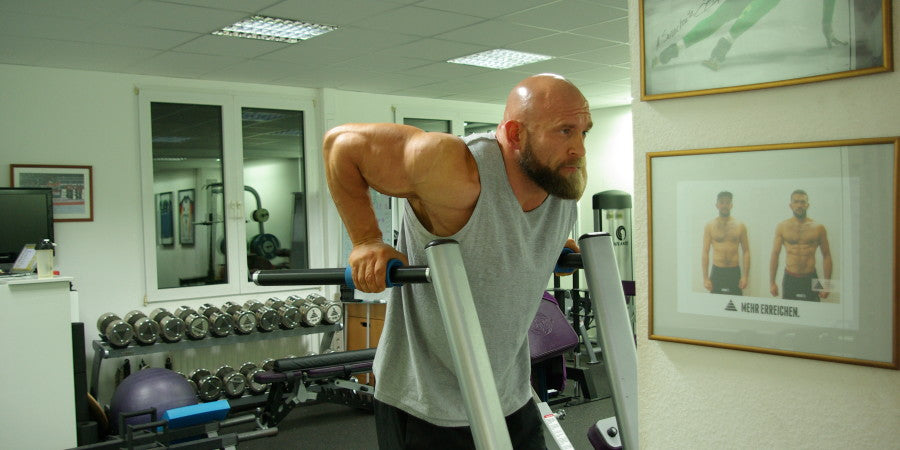Ask the Coach” is the column in which Wolfgang Unsöld answers your questions. The book of the same name was published by Riva Verlag and Available right here on Amazon.
Question: Hello Mr. Unsöld. I'd like to hear your perspective on the barbell negative bench press exercise for chest development. Nowadays you don't see this exercise in almost any gym and even when I look at training videos of professional bodybuilders nobody does this exercise. However, I once saw a video of Dorian Yates explaining the function of the pecs (pectoralis major) and then stating that the movement in the negative bench press is the closest thing to that function and he's been doing this exercise for most of his career built up and only later switched to the classic incline bench press to work on weak points. Jordan Peters, also a bodybuilder from the UK - with one of the best chest developments I've ever seen, said the activation of the chest was also highest during the negative bench press according to the EMG measurement, and this angle is the most affected weight that can be used. I would be very grateful for a rating of this exercise as a core exercise in the chest development routine. I really appreciate your articles and knowledge and am a huge fan of your books especially the one on the squat! Kind regards, Thomas H.
WU: That's a very good question. In module 2 of the YPSI Trainer B license, I go into detail about various exercises and their execution as well as their use in training planning. The negative bench press is one of those exercises that I always go into great detail about. The reason for this is that theory and practice are far apart. Basically, all statements above about the exercise are correct. The negative bench press recruits many pec fibers and allows for heavy lifting. It is also true that from a functional anatomy perspective, the pectoral muscle has four primary functions, three of which are adduction (pulling toward the body), anteversion (pulling toward the abdomen), and internal rotation of the humerus. The fourth function is shoulder flexion. These first three functions are utilized by bringing your arms down in front of your body and rotating your thumbs toward each other, as in a negative bench press. This creates a high contraction of the chest muscle and, in combination with the higher loads, a high recruitment of the muscle fibers.
As for the two bodybuilders, my first question is whether they only know if the negative bench press has this function, or whether they have actually been consistently and progressively using this exercise to build their pecs. The former would be my guess. Even if the two actually used negative bench presses as the basis of their chest training, they would be mere exceptions in the bodybuilding world, as the vast majority of bodybuilders build their sometimes-excellent pecs without any negative bench presses, but primarily through have developed bench press on the flat bench and incline bench. Prominent examples include Markus Rühl with 600 lb wide-grip flat bench, Dennis James with 500 lb incline bench press, and Ronnie Coleman with 450 lb incline rep press, as well as thousands of other bodybuilders whose primary chest exercises were the flat and incline bench press.
Turning to practice, the negative bench press has its clear advantages, primarily due to the high recruitment of chest muscle fibers as well as the heavier loads that can be used compared to other pressing exercises.
However, I do not use negative bench presses based on 3 reasons:
1. Need for a dedicated negative bench - A regular flat bench raised by a step on one side to convert to a negative bench is a commonly used solution. The big downside here is that with heavier weights, the torso tends to slide down the bench. This poses a major security risk. A special negative bench has a foot pad into which you can hook your lower leg to prevent it from slipping on the bench, but this is not available in many studios.
2. Position of the Head - On the negative bench, the position of the head is constantly below the heart, which increases the circulatory stress of the exercise and thus reduces neural drive. Blood pressure also rises disproportionately during this exercise, which under certain circumstances entails a risk.
3. Position of the shoulder - An optimal and natural position of the shoulder or shoulder blades is "back and down". This position brings the highest level of security, the lowest susceptibility to injury and the most natural movement in the shoulder joint and thus the greatest and most sustainable training progress. On a negative bench, the shoulder and shoulder blades are pushed up (as viewed from an upright torso) and forward. This entails a higher safety risk and suboptimal recruitment of scapula stabilizers and fixators. It is not possible to maintain an optimal position of the shoulders and shoulder blades on the negative bench, especially with higher, training-relevant weights. With regular training, the risk of injury to your shoulder and neck muscles increases disproportionately.
These three points are what make the negative bench press a less attractive exercise.
Nevertheless, it is crucial for the development of optimal muscular balance to train the chest, triceps and shoulder muscles in this area as well. The ideal exercise for this, and the primary form of "negative bench press" I use in training planning, are dips. Dips eliminate all three of the above and are an excellent exercise for moderate to advanced level trainees to train the identical range of motion to the negative bench press.
Good luck with dips!
Picture: IFBB bodybuilder Sven Knebel doing dips in the YPSI.

